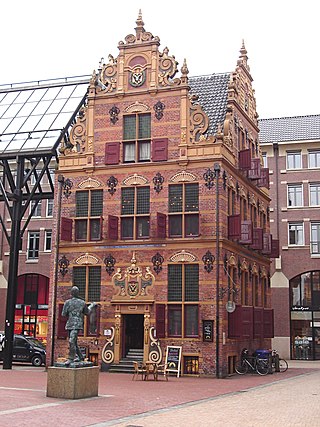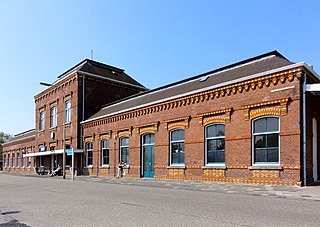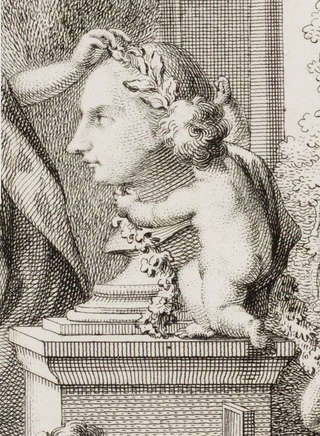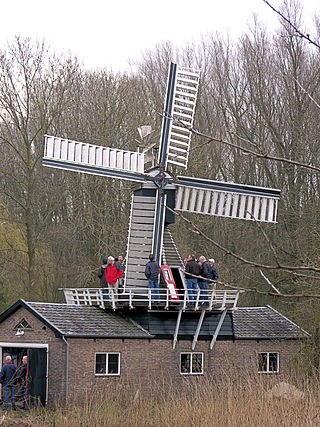
Newport Civic Centre is a municipal building in Godfrey Road in Newport, South Wales. The civic centre, which is the headquarters of Newport City Council, is a Grade II* Listed building.

The Goudkantoor is a building built in 1635 and located on Waagstraat near the Grote Markt in Groningen, Netherlands. Originally it was built as an office for the receiver of the province of Groningen when it was called Collectehuis.

Delfzijl is a railway station in Delfzijl, Netherlands. It is located on the Groningen–Delfzijl railway after Delfzijl West as the terminus for passengers. The railway line continues further east, but only for freight trains. The station building was completed in 1883 and train services started on 15 June 1884. The trains are currently operated by Arriva.

Albertdina is a smock mill in Noord-Sleen, Netherlands. It was built in 1906 and is listed as a Rijksmonument, number 33783.

Scheemda is an unstaffed railway station in Scheemda in the Netherlands. It is located on the Harlingen–Nieuweschans railway between Zuidbroek and Winschoten in the province of Groningen.

The Oval Room in the Teylers Museum was the first part of the museum that was opened in 1784. It could be entered through the garden of the fundatiehuis, the former home of Pieter Teyler van der Hulst. The building has an oval shape built around its centerpiece, a mineralogical cabinet. The Oval Room consists of two floors; the ground floor with its display cabinets and a gallery of books that connects to the Teylers Library. On top of the room, on the roof, the astronomical observatory used to be a landmark that could be seen for miles along the river Spaarne. The gallery and observatory are longer accessible to the public, though the gallery can be seen from the ground floor.

The Weesp City Hall is the former city hall of Weesp, Netherlands. The main body of the municipality, the municipal council, convened in the Raadzaal until 24 March 2022 when Weesp became part of the municipality of Amsterdam. The administrative offices have moved, but the former Vierschaar and Burgerzaal are still used for weddings and other official proceedings. The rest of the building is in use as the local museum of Weesp.

Jacob Otten Husly was an 18th-century architect from the Northern Netherlands.

Spinnenkop Wedderveer is a wind powered sawmill in the village of Wedderveer, Groningen, Netherlands. It is a hollow post windmill of the type called "spinnenkop" by the Dutch built on top of a brick shed. The mill is listed as a Rijksmonument, number 388083 and is in working order.

The Gotisch huis is one of the oldest buildings in the city of Groningen, Netherlands. It is a rijksmonument since 1971. Built in the 14th century it is widely seen as the oldest residential building remaining in the city, this fact was mentioned when it became a rijksmonument, even though the Calmershuis that was built in 1250, and mentioned as being a mayor's house, is older. Together with the nextdoor building, the Canterhuis, it is currently in use by the Northern Maritime Museum.

The Korenbeurs is a neoclassical building in Groningen in the Netherlands. It was originally used as an exchange for food grain trade. Its current tenant is Albert Heijn.

The Rechthuis is a former courthouse in the village of Bellingwolde in the Netherlands. The building with two crow-stepped gables was established in 1643 and used as a civil court for the area Bellingwolde-Blijham until 1811. The building has been a national heritage site since 1972. It is currently used as a private residence.

Gloucester Shire Hall is a municipal building in Westgate Street, Gloucester. The shire hall, which is the main office and the meeting place of Gloucestershire County Council, is a grade II listed building.

The St. Joseph Cathedral is the cathedral of the Roman Catholic Diocese of Groningen-Leeuwarden in the city of Groningen in the Netherlands.

Preston Town Hall is a municipal building in Lancaster Road in Preston, Lancashire, England. The town hall, which is the headquarters of Preston City Council, is a Grade II listed building.

Newark Town Hall is a municipal building consisting of a town hall, assembly rooms and a market hall in Newark-on-Trent, Nottinghamshire, England. It is a Grade I listed building.

Barcelona City Hall is the seat of Barcelona City Council. It is situated in the Plaça Sant Jaume in the Gothic Quarter, opposite the Palau de la Generalitat de Catalunya housing the regional government.

Rotterdam City Hall was built between 1914 and 1920 by Henri Evers. It is one of the few buildings in the center of Rotterdam that survived the bombing of May 14, 1940. Since 10 October 2000 it has been recognized as a Rijksmonument.

The Nieuwe Kerk, in the 18th century also called Noorderkerk, is a Protestant church in the city of Groningen, located on the Nieuwe Kerkhof in the Hortusbuurt.

The Oosterkerk is a reformed church from 1929 in the Dutch city of Groningen. It is located in the Oosterparkbuurt, on the corner of the E. Thomassen à Thuessinklaan and the S.S. Rosensteinlaan.
























